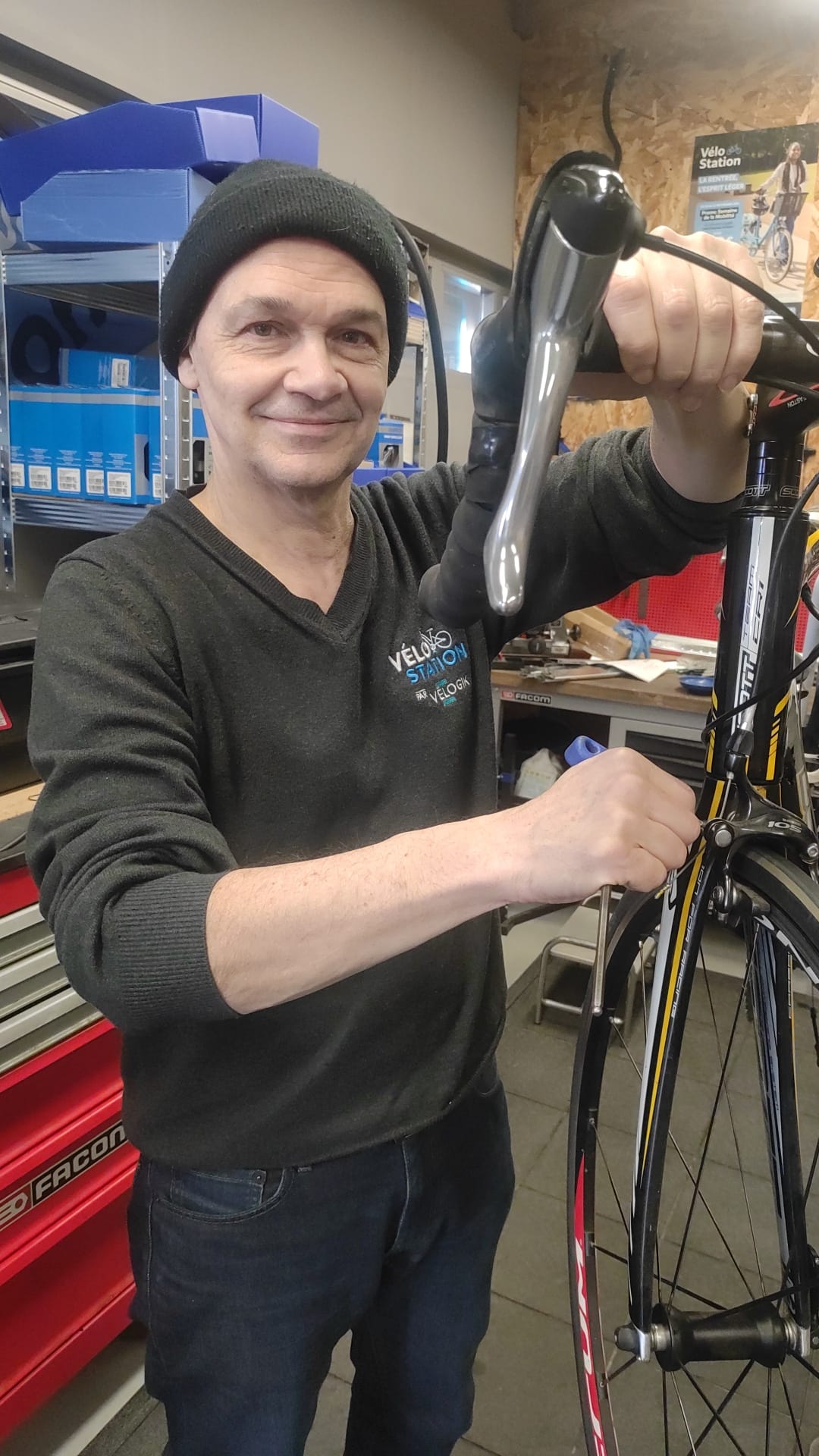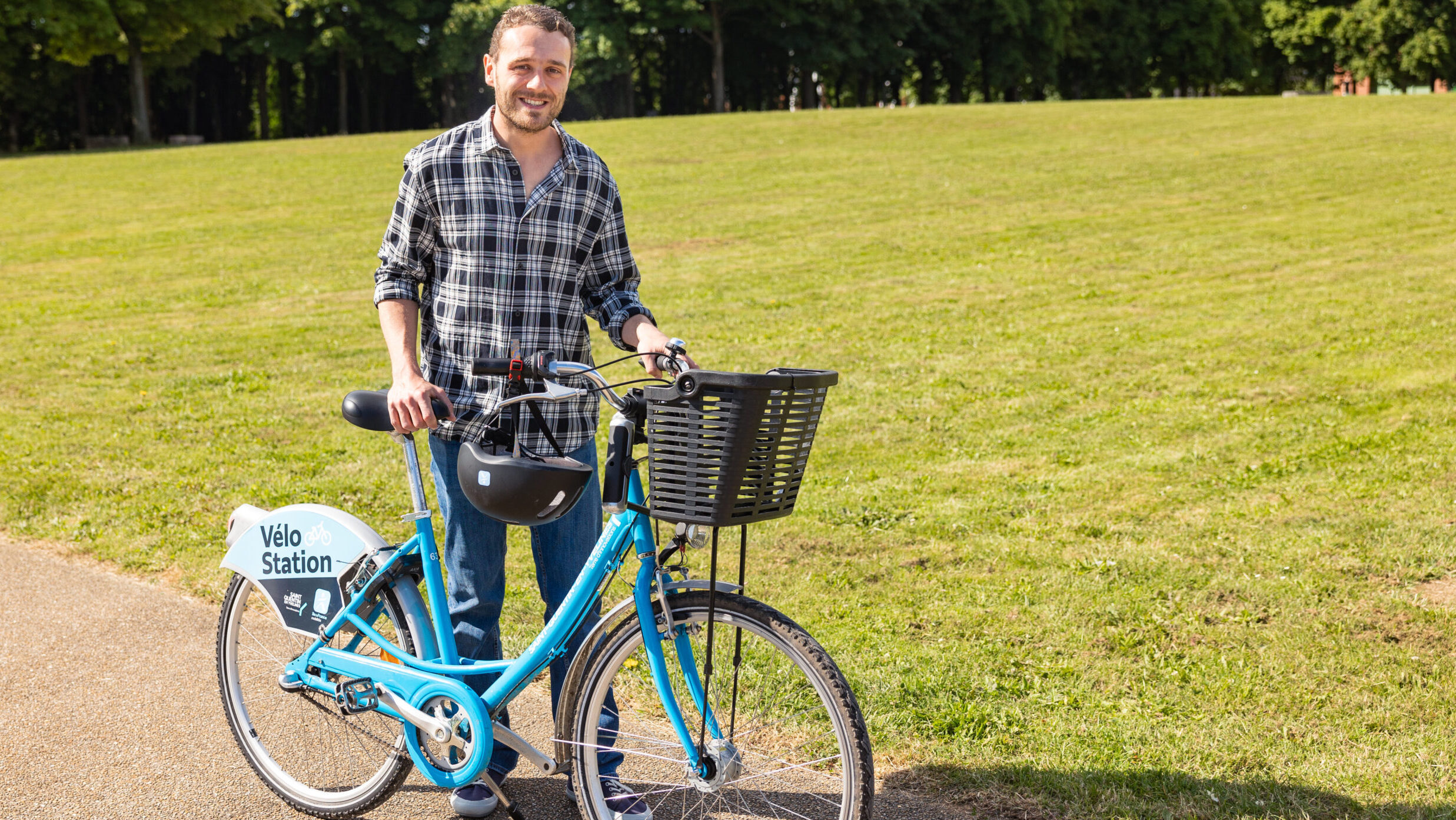SQY’s VéloStation is a bicycle solution for developing cycling mobility in all regions. Richard Bornant is responsible for managing the Saint-Quentin-en-Yvelines bike station. This is a key service for local users wishing to repair or maintain their bicycles. Find out more about his experience here.
With a wealth of experience in the industry, he stands out for his responsive, customer-oriented approach. Richard also plays an important role in expanding the station’s services. He works with colleagues to offer mobile repair solutions in the local area.

A bicycle solution for mobility: The Saint-Quentin-en-Yvelines bike station
With the growth in soft mobility and the development of large-scale cycling infrastructures, the Saint-Quentin-en-Yvelines bike station is a key solution. It’s part of the region’s ecological transition. Located right next to the train station, this facility offers a range of innovative services. These bicycle services are available to meet the growing needs of users. In this interview with Richard Bornant, in charge of the bike station, we take a look behind the scenes of this initiative. Find out how it’s transforming the way residents get around on a daily basis.
A bicycle solution to develop reactive and accessible bicycle repair services
The Saint-Quentin-en-Yvelines bike station is more than just a place to rent. It’s also a repair center that stands out for its speed and proximity to users. Richard Bornant, who manages the station, explains:
“Saying to someone: ‘You’ve got a punctured bike, come and pick it up in a week’ is inconceivable. Users rely on their bikes to get around on a daily basis, so guaranteeing them a fast repair is essential. That’s what sets us apart from other services, where repair times can be as long as 8 or even 15 days.”
Indeed, the Saint-Quentin-en-Yvelines bike station stands out for its ability to intervene quickly. On average, a puncture is repaired in 10 to 15 minutes. However, for more complex breakdowns requiring parts changes, the time can be longer, but the service remains responsive. Richard tells us:
“When it comes to changing components like the chain, derailleurs, or even chainrings, it can take an hour or even two. But overall, we try to keep waiting time to a minimum, because we know that every minute counts for our customers.”
A well-organized team for smooth management
Beyond repairs, managing the bikes in the station is another key aspect of the organization. Richard Bornant describes how the day begins at the bike station:
“It all starts early in the morning, around 7:30, when I take the time to take stock of the workload. We have to deal with emergencies, such as repairs that need to be done during the day. We often have requests for cargo bikes, Veligo, or VAEs (electrically assisted bicycles), and it’s up to us to plan efficiently to meet everyone’s needs.”
To guarantee a fast, high-quality response, Richard and his colleagues work together. In this way, optimum coordination is achieved to ensure that every bike is repaired as quickly as possible.
Focus on the impact of the Olympic Games on the development of bicycle mobility
A key moment for the Saint-Quentin-en-Yvelines bike station was during the Paris 2024 Olympic Games. The station, located just 200 meters from the velodrome, saw an influx of new visitors. Richard looks back on this intense period:
“During the Games, we had a huge number of visitors, and it was a real opportunity to showcase our service. People came from all over – from Paris, from the Paris region – and many needed to repair their bikes on the spot, because with the arrival of fine weather, many got their bikes out of the cupboards again.”
The timing was perfect to introduce the resort to a wider public, thanks in particular to the influx of visitors who came to watch the cycling competitions. “It was a real logistical challenge, but also an excellent communication opportunity,” confides Richard.“We were able to take advantage of the opportunity to publicize our services and highlight our responsiveness.”
Ramping up the mobility service
Another interesting aspect of the bike station is the evolution of the service towards true local mobility. The idea of making the station even more accessible has led to the introduction of new services. Six months ago, a new colleague, Thibault Planchon, joined the team with a key role: he is in charge of mobility and carries out interventions in neighboring communes. Richard explains:
“Thibault travels with a trailer and a vehicle in the 12 towns of the agglomeration. As a result, users can now benefit from repairs carried out directly in their own homes or close to their place of work. This service is a real plus for those who don’t have the time to do it themselves. . But also for those who have no means of transport to get there.”
This mobile service is particularly well suited to users’ needs. Users are looking for a fast, convenient solution, without having to travel to the station. An ideal solution for those on a tight schedule. But also for those who depend on their bike for their daily commute.
A response to the challenges of daily travel
The success of the bike station depends on its ability to meet user expectations. The environment is constantly evolving. The Saint-Quentin-en-Yvelines conurbation has developed a high-quality cycling infrastructure. We can see that residents are increasingly turning to bicycles for their journeys. Richard tells us about the changes he has observed:
“The conurbation has set up a very dense network of cycle paths, with plans to have almost 600 km of lanes reserved for cyclists by 2031. This has really encouraged the use of bicycles as a means of daily transport.”
The station has adapted to this evolution by offering fast, accessible service. For Richard, the mission is clear:
“Our aim is to make it easier for users to get around, by offering fast and efficient repairs. We know that a broken-down bike can become a real drag on people’s daily lives, especially for those who use it every day to get to work.”
The future of the bike station: outreach and development
The development of the Saint-Quentin-en-Yvelines bike station is far from over. With the extension of its services and its influence beyond the town’s borders, Richard Bornant is confident about the future:
“We’ve come a long way in recent months. The station is no longer just a repair point, it has become a true mobility service center. The mobile service allows us to reach more people in the region and reinforce our position as a key player in the transition to more sustainable mobility.”
The outlook is therefore promising, and the bike station looks set to keep pace with the growth in cycling in the region.
The future of cycling solutions
The Saint-Quentin-en-Yvelines bike station embodies the future of sustainable mobility, with a hybrid model combining repair services, rentals and user advice. Thanks to an agile and responsive organization, the team around Richard Bornant offers a quality service, with a direct impact on the daily commutes of the area’s inhabitants. If Île-de-France Mobilité continues to invest in its cycling infrastructure and services like this one multiply, cycling will surely become an essential mode of transport in the years to come.
“We’re here to meet users’ needs and support them in their daily lives, by offering fast and efficient repair solutions,” concludes Richard Bornant. “Cycling is a real alternative to the car, and our role is to facilitate this transition.”
Richard Bornant
Find out more
The Saint-Quentin-en-Yvelines bike station is an inspiring model for the future of sustainable mobility. With a hybrid offering combining rapid repair, mobile services and user support, it provides an effective response to the challenges of daily commuting, while boosting the adoption of cycling as an alternative to the car.
To find out more about Vélogik’s expertise and its key role in similar projects, read this article from Maison du Vélo , which illustrates their commitment and know-how in the management and operation of cycling infrastructures.



